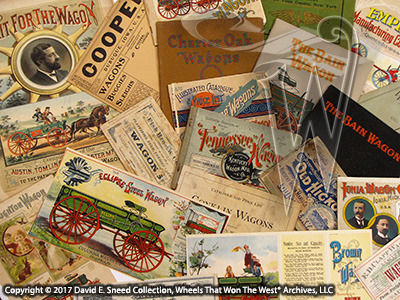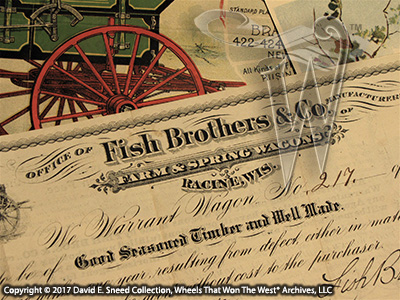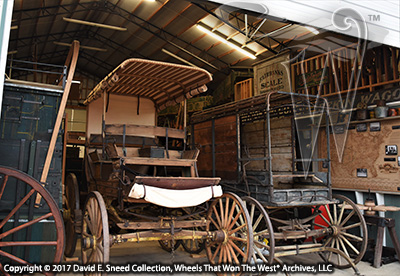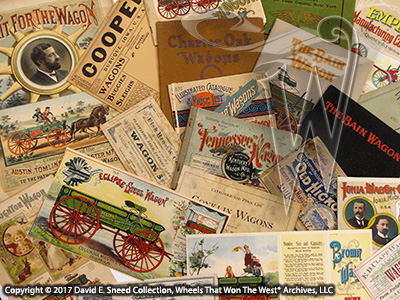It's been close to a quarter century since I became intrigued with America's first transportation industry. In the beginning, it was tough to know where to find accurate, well-researched information. The internet was in its infancy so there was no real option to "go on-line" and find material. My quest to know more eventually led me to a used book store in Springfield, Missouri. I took home a single book on my first visit but, that successful find provided the encouragement to keep digging.
After that, anytime I happened to be in the city, I stopped by the bookstore. I'd say that at least every other trip resulted in the discovery of an additional resource covering some aspect of nineteenth century vehicles. From there, I scoured the credits and bibliographies, leap-frogging from one period source to another until I had acquired many of those same books for my library. Most of the volumes were out-of-print and tough to find. However. eventually, the internet became more mature, helping expand my search options. On-line stores like Ebay and others became a fertile hunting ground for original materials. As I secured more and more primary source pieces (period brochures, flyers, correspondence, photos, news accounts, ledgers, and the like), I not only began to see notable differences in many builders but also saw generational design shifts and other details that helped me determine what was and what wasn't a good investment opportunity.

This small grouping of literature highlights the hundreds of brochures and countless original documents in the Wheels That Won The West®ÃƒÆ’¢Ãƒ¢Ã¢â€š¬Ã…¾¢ Archives.

This image shows a detailed segment of an 1875 warranty for a Fish Bros. wagon. The document includes imagery of the vehicle designs and features for that era. As was the case for many wagons built in the latter part of the nineteenth century, the warranty was for 1 year.
As time went on, I began writing feature articles on the topic and we launched a website to share some of the things we'd discovered. Then, six years ago, in a moment of clear delusion and weakness, I took on another, even weightier challenge- writing weekly blog posts. I soon discovered how little I really knew about this whole subject. In fact, if you want to know how much you truly KNOW about any historical element - beyond your own life story - start writing about that theme with length and an objectivity that requires first-hand accounts to back you up. In other words, eliminate hearsay, speculation, and best guesses as well as any unsubstantiated claims from all of your documentation. It's surprising just how much of our world runs on unsupported notions.
In our files, I have quite a number of stories that are started yet unfinished due to the need for more research (and time). As the past half dozen years have transpired, the self-imposed exercise of discovery has done something I didn't expect - it sucked me even deeper into an abyss of questions and long-forgotten history. In truth, I never had a plan for the writings - just the launch of a new topic every week. It's a direction that has the potential to never reach an end while constantly delivering new revelations. In fact, even with all of those hours of intensive research, extensive travel, dead-end investigations, surprise discoveries, and hurried writings to meet our Wednesday morning deadlines, some things never changed. The process has consistently delivered some of the most exciting, challenging, frustrating, time-consuming knowledge-enhancing, and personally rewarding segments of my life - as well as the opportunity to meet a host of wonderful and truly interesting people.
Even so, this much writing is not a milestone I set out to achieve. If I'd known how much commitment it would take, I likely wouldn't have had the courage to start. After researching and writing almost 325 regular blogs and multiple feature articles during the past 72 months, it's been a true exercise in humility. That said, it's also been a privilege as we've helped shed more light on the depth and complexity of America's first transportation industry.
During the first half of December in 2011, I wrote and posted the first weekly blog. It was pretty short and sweet compared to later pieces. Some of the stories we shared came easy while others made me dig deep for answers and forgotten details. The subjects surrounding America's early wagons, coaches, and western vehicles are so involved that it can be overwhelming to realize just how much we still don't know. It's made me often wonder that, if we truly live in the 'Age of Information,' how can we know so little about the very products and industry that drove virtually every aspect of our nation's growth in the nineteenth and early twentieth centuries? Honestly, how much history have we all overlooked because we didn't know how, when, where, and why to look? How much do we still share as truth that couldn't be proven if a person wanted to try? Why aren't we more curious about these things? These, and so many more questions, are areas that I still want to discover more about - before the last primary sources are lost forever.

Keeping investment-grade vehicles and other collectibles inside and protected from the weather, insects, animals, dirt floors, and other adversities is important to the well-being of each piece.
I've said all of this a prelude and, I guess, an apology of sorts. As we close out 2017 and I wrap up this week's blog, I've come to the hard decision that I need to ease up on the frequency of my posts. There are only so many hours in the day and there are a host of other duties my day job rightly requires. To so many of you that have been loyal supporters along the way, I want to express my sincere thanks. My interest in the heavier farm, freight, ranch, coach, business, and military vehicles so prominent in the development of the United States hasn't waned. Likewise, I expect my historical search and rescue efforts to continue unabated. I'm as intrigued with the discovery process as I've ever been and the location and preservation of primary source materials (including the vehicles themselves) remains a top priority. Nonetheless, it's become increasingly challenging to share the depth in the posts that I'd like.
So, for the time being, I'm looking at spreading out the blogs a bit. If you're reading this and haven't signed up for notification of these postings, you may want to consider it. Those folks that are on the list will receive priority notice when new blogs are released in the future. In the meantime, I still expect to embrace occasional speaking engagements and will likely write more feature articles. As with many avid collectors,I have objectives and goals for our vehicle, signage, and ephemera collection and those efforts will continue. Likewise, it's my hope that these writings will continue to help others in their own collections, research, and understanding of such a central and important part of U.S. development.
In the meantime, I wish each of you the very best as well as a Merry Christmas and Happy New Year!
DavidPlease Note: As with each of our blog writings, all imagery and text is copyrighted with All Rights Reserved. The material may not be broadcast, published, rewritten, or redistributed without prior written permission from David E. Sneed, Wheels That Won The West® Archives, LLC
